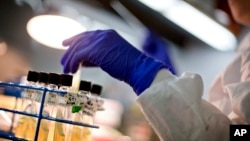Scientists have tweaked a powerful antibiotic, called vancomycin, so it is once more powerful against life-threatening bacterial infections. Researchers say the more powerful compound could eliminate the threat of antibiotic resistance for many years to come.
Antibiotic resistance, in which microbes no longer respond to drugs, is quickly becoming a global health emergency. Of particular concern are so-called “superbugs,” a handful of pathogens that patients acquire in hospitals and other health care settings. Patients recovering from surgery are particularly vulnerable to the resistant, hospital-borne infections, which put them at high risk of death.
Researchers at The Scripps Research Institute in La Jolla, California, modified vancomycin, invented 60 years ago and considered a last resort treatment against many of these infections. They made a key change to its molecular structure, interfering with how the bacterium, enterococcus, makes protective cells walls.
In a new study published in the journal Proceedings of the National Academy of Sciences, investigators describe how the change made vancomycin 1,000 times more effective against both drug-resistant enterococci and the original forms of the microorganism.
‘Total cures’
The modification is in addition to two previous changes made by the Scripps team that improved the drug’s potency, so less of it is needed to treat an infection.
Lead researcher Dale Boger, who co-chairs the institution’s Department of Chemistry, said it is difficult for enterococcus to find a way around three independent mechanisms of action. “Even if they found a solution to one of those,” said Boger, “the organisms would still be killed by the other two.”
The challenge now for researchers is to reduce the number of steps it takes in the lab to boost vancomycin’s effectiveness. Having redesigned the antibiotic’s molecular structure, Boger called streamlining its production the “easy part.”
Even if researchers are unable to simplify the way the improvements are made, Boger said efforts to supercharge vancomycin are worth it for the antibiotic’s lifesaving powers, calling the drugs “total cures” against bacterial infection.
Given the growing failure of antibiotics to treat common infections, Boger said making the super-charged vancomycin molecule is important, even if it’s labor-intensive.






